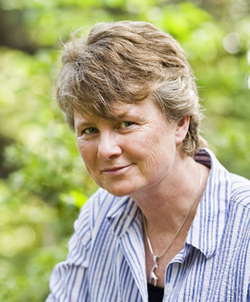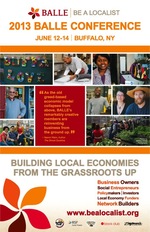
From Me to We
By Jay Burney
June 13, 2013
Janine Benyus, author of “Biomimicry, Innovations Inspired by Nature” and President of the Biomimicry Institute has an important message for the Business Alliance For a Local Living Economy Conference (BALLE 2013) being held in Buffalo. “Just take care of your place and it will take care of you.”
The message resonated in the crowd of localist economy activists, entrepreneurs, and innovators, gathered for the 11th Annual Conference which is being held for the first time in Buffalo.
Biomimicry is the science of trying to understand how nature works, how humans are a part of nature, and how humans can better stand a chance to survive and thrive if they adopt important natural principles.
“Organisms and the ecosystems and services that they provide for take care of the place so that 10.000 generations from now, there will still be a place” she told the enthusiastic audience. 10,000 generations? How often do we think about our social, economic, and environmental impacts on the next generation? In business, it’s the next quarter isn’t it? The future? -What a concept!
Many of the BALLE participants are deep into the politics of economics. The contrasting philosophies and on the ground struggles between the concepts of dog eat dog competition v. the cooperative nature of working for the greater good of building communities and economies from the ground up are consistent themes of the BALLE movement. Thinking about how to move the effort away from the “me”, to the “we” is a fundamental concept of both nature and sustainability. Thinking about how our economy will effect future generations is a substantial characterization of localism. Localists will tell you that if you are a part of a localist movement, you care about the people, the places, and the environment. You come to think about making sure that as the tide rises, all people have floatable boats. If you have a purely global focus, you work to extract of wealth and ignore the damage to the environment and society, justice issues that become nothing more than “externalities” to the profit taking.
Although it is still considered heretical in many scientific circles, Benyus said, “science is more and more discovering that cooperation, or mutualism, has a strong place in the way that systems, ecosystems survive”. In other words it is not just about survival of the fittest. Parts of systems work together to create the healthy whole. Biodiversity requires mutualism and cooperation. Biodiversity creates opportunity and sustains life.
As an example she describes Mycorrhizal Fungi. “Living soils have dense networks of this fungi that connects organisms and serves as both a communication system and a support system in terms of helping to share water and nutrients amongst organisms.” “We call it the Common Mycorrhizal Network (CMN) and it connects, defends, and supports the world. It is part of the symbiotic and deeply shared cooperation that characterizes how an organisimistic society knits together.” This is a profound description of how a cooperative system allows biodiversity to flourish and life to thrive. It is more than a metaphor about how our economic system is modeled. “This mutualism demonstrates that ecosystems are generous rather than strictly competitive,” Benyus tells us.
She continues. “Humans are mostly oblivious to this. Our factory agricultural system is intent on killing soils and introducing synthetic toxins that destroy biodiversity and destroy life opportunities.” Development of any sort pays little attention to how nature survives and thrives, which effects how humans survive and thrive. This knowledge is consequential.
Nature is very efficient and natural systems produce no waste. Ubiquitous natural polymers such as cellulose, starch, RNA, keratin, silk, collagen, help to characterize such things as strength, elasticity, and water solubility and help produce the structures of life forms including bones, wood, shells, claws, and spider webs. Natural polymers are biodegradable and are not waste products. Humans have introduced more than 350 non- biodegradable and toxic polymers including polystyrene and plastics. This toxic waste stream is one of the great tragedies of humanity and are direct results and consequences of the political economic decisions of a consumer society. Biomimicry can help us move toward the use of natural or natural influenced polymers, help us reduce waste, and help us to detoxify the planet.
A very exciting development is the Biomimicry Institute’s (Biomimicry 3.8-reflecting 3.8 billion years of evolution) new emphasis on urban structures and infrastructure. Later this month the 7th annual Biomimicry Education Summit and Global Conference will be held in Boston. Benyus told us that there will be an emphasis on promoting resilient cities, which will include developing and refining metrics on ecological performance standards for development. When we replace an ecosystem with a city, we remove its ecological services. Do we have to do that? We are just learning what that means. As we understand ecological services better including water and air filtration, carbon sequestration, heating and cooling influences of urban trees, and how that effects climate change. Benyus told us that she was in a new building in Manhattan and was told that the air filtration system in the building returns air to the outside that is 3 times more clean than the air that enters the building. “That’s a good starting point to think about this”, she said. “Our cities can find ways to be generous if we learn from ecosystems and how they create opportunities for 10,000 generations. Buffalo could take a great leap forward if you work with us on developing and implementing ecological performance standards.”
Perhaps the fundamental message of the BALLE Conference is about cooperation as opposed to competition. Can human systems including political economic systems find cooperative ways to thrive and help lift all boats. According to Janine Benyus, Lets move from me, to we. Just ask nature. Most people at BALLE2013 would agree.
Links:
Janine Benyus Ted Talk:The Promise of Biomimicry
http://www.ted.com/talks/janine_benyus_shares_nature_s_designs.html
Biomimicry 3.8 Institute
http://biomimicry.net/about/biomimicry38/institute/
7th Annual Biomimicry Education Summit and Conference, Boston
http://biomimicry.net/educating/summits-workshops/education-summit/




 RSS Feed
RSS Feed